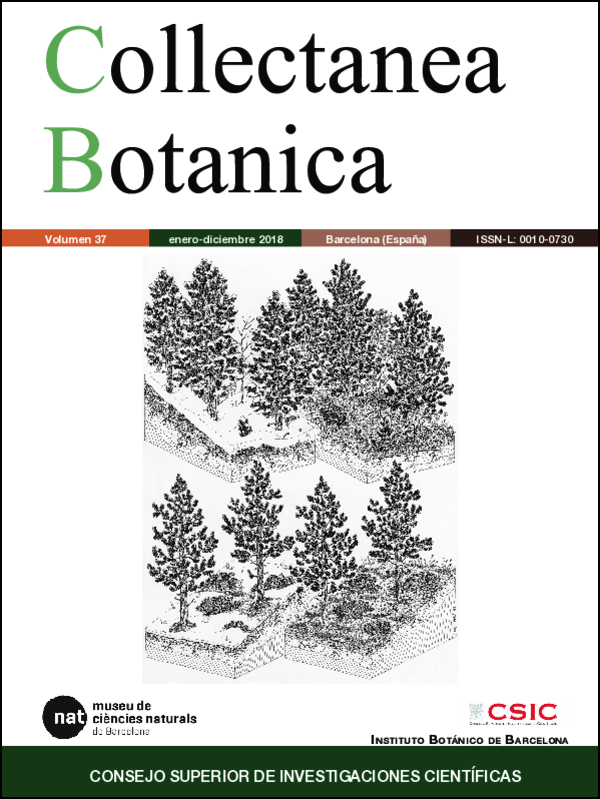Notas taxonómicas y nomenclaturales a propósito de Vicia aphylla (Fabaceae)
DOI:
https://doi.org/10.3989/collectbot.2018.v37.002Palabras clave:
Canarias, Christen Smith, Cracca, Fabaceae, neotipo, Vicia cirrhosa, Webb & Berthelot, Canaries, nèotypeResumen
Se presenta la neotipificación del nombre Vicia aphylla C. Sm. ex Buch con un ejemplar procedente del antiguo herbario personal de Jens Wilken Hornemann depositado en el herbario del Museo de Historia Natural de Dinamarca (C). Además, se discute la conveniencia de usar este nombre frente a Vicia cirrhosa C. Sm. ex Webb & Berthel. [fr] Avec ce travail nous présentons la néotypification du nom Vicia aphylla C. Sm. ex Buch avec un échantillon de l’ancien herbier personnel de Jens Wilken Hornemann déposé dans l’herbier du Musée d’Histoire Naturelle du Danemark (C). En plus, on discute la convenance d’utiliser ce nom en contre de Vicia cirrhosa C. Sm. ex Webb & Berthel.
Descargas
Citas
Acebes Ginovés, J. R., León Arencibia, M. C., Rodríguez Navarro, M. L. et al. 2010. Spermatophyta. In: Arechavaleta, M., Rodríguez, S., Zurita, N. & García, A. (Coords.), Lista de especies silvestres de Canarias. Hongos, plantas y animales terrestres. 2009. Gobierno de Canarias, Santa Cruz de Tenerife: 122–172.
Allkin, R., Goyder, D. J., Bisby, F. A. & White, R. J. 1986. Names and synonyms of species and subspecies in the Vicieae: Issue 3. Vicieae Database Project (Experimental Taxonomic Information Products, Publication 7). University of Southampton, Southampton.
Bornmüller, J. 1904. Ergebnisse zweier botanischer Reisen nach Madeira und den Canarischen Inseln. Botanische Jahrbücher für Systematik Pflanzengeschichte und Pflanzengeographie 33: 387–484.
Bramwell, D. & Bramwell, Z. 1994. Flores silvestres de las Islas Canarias. Editorial Rueda, Madrid.
Buch, L. von 1819. Allgemeine uebersicht der flora auf den Canarischen Inseln. Abhandlungen der physikalischen Klasse der Königlich-Preu?sischen Akademie der Wissenschaften 1816–1817: 337–384.
Buch, L. von 1825. Physicalische beschreibung der Canarischen Inseln. Berlin.
Burchard, O. 1929. Beiträge zur ökologie und biologie der Kanarenplanzen (Bibliotheca Botanica, 98). E. Schweizerbart'sche Verlagsbuchhandlung, Stuttgart.
Christ, H. 1885. Vegetation und flora der Canarischen Inseln. Engler's Botanische Jahrbücher 6: 458–526.
Gil, J., Gil, M. L., Morales, J. B. & Mesa, R. 2012. Vicia vulcanorum (Fabaceae) a new species from the island of Lanzarote (Canary Islands). Collectanea Botanica 31: 19–27. https://doi.org/10.3989/collectbot.2012.v31.002
Gil, J., Morales, J. B., Gil, M. L. & Mesa, R. 2013. Vicia voggenreiteriana (Fabaceae) a new species from the island of La Gomera (Canary Islands). Vieraea 41: 189–201.
Gray, S. F. 1821. A natural arrangement of British plants 2. Baldwin, Cradock and Joy, London.
Gunn, C. R. 1979. Genus Vicia with notes about tribe Vicieae (Fabaceae) in Mexico and Central America (United States Department of Agriculture Technical Bulletin, 1601). United States Department of Agriculture, Washington, DC.
Hanelt, P. & Mettin, D. 1989. Biosystematics of the genus Vicia L. (Leguminosae). Annual Review of Ecology and Systematics 20: 199–223. https://doi.org/10.1146/annurev.es.20.110189.001215
Hansen, A. 1977. On Christen Smith's Names of Canarian Plants. Botanica Macaronesica 3: 25–34.
Hohenester, A. & Wel?, W. 1993. Exkursionsflora für die Kanarischen Inseln. Verlag Eugen Ulmer, Stuttgart.
Kunkel, M. A. & Kunkel, G. 1978. Flora de Gran Canaria 2. Enredaderas, trepadoras y rastreras. Cabildo de Gran Canaria, Las Palmas.
Kupicha, F. K. 1976. The infrageneric structure of Vicia. Notes from the Royal Botanic Garden, Edinburgh 34: 287–326.
Lindinger, L. 1926. Beiträge zur kenntnis von vegetation und flora der Kanarischen Inseln (Abhandlungen aus dem Gebiet der Auslandskunde, 21). Kommissions-verlag L. Friederichsen & co., Hamburg.
McNeill, J., Barrie, F. R., Buck, W. R. et al. (Eds.) 2012. International Code of Nomenclature for algae, fungi, and plants (Melbourne Code): Adopted by the Eighteenth International Botanical Congress, Melbourne, Australia, July 2011 (Regnum Vegetabile, 154). Koeltz Scientific Books, Königstein.
Pitard, J. & Proust, L. 1909. Les Îles Canaries. Flore de l'Archipel. Librairie des Sciences Naturelles, Paul Klincksieck, Paris.
Santos Guerra, A. 1983. Vegetación y flora de La Palma. Editorial Interinsular Canaria, Santa Cruz de Tenerife.
Schönfelder, P. & Schönfelder, I. 2012. Die Kosmos-Kanarenflora. Kosmos, Stuttgart.
Smith, C. 2002. Diario del viaje a las Islas Canarias en 1815 [Trad. Cristina S. Hansen]. (Materiales de Historia de la Ciencia, 8). Fundación Canaria Orotava de Historia de la Ciencia, La Orotava.
Sprengel, C. 1826. Systema Vegetabilium 3. Sumtibus Librariae Dieterichianae, Gottingae.
Stafleu, F. A. & Cowan R. S. 1976. Taxonomic Literature 1 A-G (2nd ed.). Bohn, Scheltema & Holkema, Utrech.
Stearn, W. T. 1937. On the dates of publication of Webb and Berthelot's "Histoire Naturelle des Îles Canaries". Journal of the Society for the Bibliography of Natural History 1: 49–63. https://doi.org/10.3366/jsbnh.1937.1.2.49
Stierstorfer, C. & Gaisberg, M. von 2006. Annotated checklist and distribution of the vascular plants of El Hierro, Canary Islands, Spain (Englera, 27). Botanischer Garten und Botanisches Museum Berlin-Dahlem, Berlin.
Webb, P. B. & Berthelot, S. 1836–1850. Histoire naturelle des Îles Canaries. Béthune, Paris.
Publicado
Cómo citar
Número
Sección
Licencia
Derechos de autor 2018 Consejo Superior de Investigaciones Científicas (CSIC)

Esta obra está bajo una licencia internacional Creative Commons Atribución 4.0.
© CSIC. Los originales publicados en las ediciones impresa y electrónica de esta Revista son propiedad del Consejo Superior de Investigaciones Científicas, siendo necesario citar la procedencia en cualquier reproducción parcial o total.
Salvo indicación contraria, todos los contenidos de la edición electrónica se distribuyen bajo una licencia de uso y distribución “Creative Commons Reconocimiento 4.0 Internacional ” (CC BY 4.0). Consulte la versión informativa y el texto legal de la licencia. Esta circunstancia ha de hacerse constar expresamente de esta forma cuando sea necesario.
No se autoriza el depósito en repositorios, páginas web personales o similares de cualquier otra versión distinta a la publicada por el editor.














